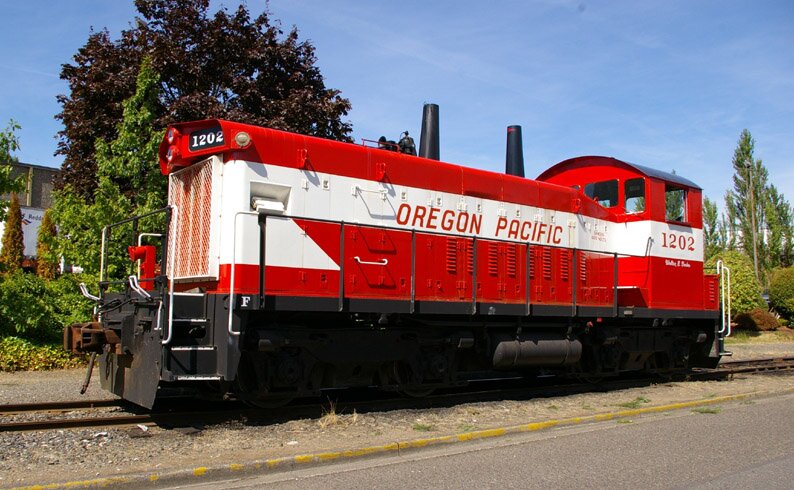| Oregon Pacific Railroad 1202 |
| Last Update: April 10, 2013 |
| "Walter B Beebe" |
| The OPR 1202 is one of Mr. Samuels newer diesels. Named after Walter B Beebe. A friend and mentor of Mr. Samuels, shown in this 1959 photo while a member and operator of the Shady Dell live scale railroad that Mr. Samuels also belongs too. The 1202 is a GMD 1200RSu. It served with the Canadian Pacific. After the sale of the OPR 1810, the 1202 is now also the most powerful diesel in the OPR fleet, making 1200 h.p. along with the OPR 1201/1413 which also makes 1200 h.p. According to Canadian Pacific Roster information, the 1202 began life in 1953 as an GMD SW9 B/N A492 in February of 1953 and was originally numbered 7403. The original prime mover was an EMD 12-567-B V-12, making 1200 h.p. Between September and December, 1982, it was completely rebuilt from the ground up as a brand new SW1200RSu by GMD, including new engine, new cab electronics, control stand, renumbered 1202. The prime mover was upgraded to a C Block 12-567-C with the addition of EMD 645 power assemblies, making 1200 h.p. and the locomotive was redesignated an SW1200RSu. At some point, probably in the early to mid 1990s, the original trucks were swapped out for a set of EMD Flexi-coil trucks. Canadian Pacific's 1989 Motive Power summary indicates that the 1202 retained 12-567-B block engine as of at least 1989, but the 1202 is current configured entirely as SW1200RSu, including the before mentioned 567C, 654 power assemblies, modern EMD control stand, modern wiring and electronics that match other SW1200RSu locomotives. It's not clear why the discrepancy. The 1202 has a unique headlight/reader board hood that appears to be unique to Canadian built SW1200RSu locomotives. A series of photos of the 1202 when operating for the CP can be seen here. The 1202 was overhauled again in the 1990s. It appears the CP retired the 1202 in January 1999. It was then sold to Helm Financial Corporation (HMLX), who later sold it to Larry's Truck & Electric (LTEX), a locomotive broker, from whom Mr. Samuels purchased it in approximately 2005. The 1202 served most of its OPR career as the work horse of the East Portland Branch, servicing most trains on that branch, while being augmented by the No. 100 as the back up engine. In early 2013, the 1202 was moved to the OPR's Molalla Division to replace the No. 801 which was down for repairs. The OPR No. 1413 took over the 1202's duties on the East Portland Division. When the No. 801 is repaired, the 801 and 1202 will share primary switching duties on the Molalla Division. Here is a photo of the 1202 at LTEX after it received fresh paint prior to being delivered to the OPR. The 1202 can be seen switching out cars with the SP&S 700 at East Portland, in this video of the 50th Anniversary, End of Steam, 2006 The 1202 can also be seen in this cab ride video of the OPR 1202 switching out the 2007 Holiday Express and the SP 4449 |
| More pictures can be found here. |
| Various photos of the 1202 in action in 2006 and 2007. |
| Photos of the cab of the 1202, including Mr. Samuels at the controls in 2007. |
| History of the OPR - East Portland Branch - Molalla Branch - Videos of the OPR in Action News & Upcoming Events - Photos of Past Events - Roster of the OPR |
| Copyright © 2004-2010 All Rights Reserved Webmaster Brian McCamish In Search of History Expeditions Active & Abandoned Railroads of the Northwest Webmaster |

| History of the OPR - East Portland Branch - Molalla Branch - Videos of the OPR in Action News & Upcoming Events - Photos of Past Events - Roster of the OPR |
| The 1202 switching out consist at the beginning of the June, 2008 Steaming through History event with the SP&S 700. |
| The 1202 switching out consist at the end of the June, 2008 Steaming through History event with the SP&S 700. |
| The 1202 making a revenue run southbound on the East Portland Branch, with Kevin Novak's speeder in the Oaks Park siding. Photo courtesy of Kevin Novak. |
| Photos of the 1202 in action in 2008 |
| The 1202 pulling a small charter train in January, 2009 |

| Oregon Pacific Railroad No. 1202 |
| Oregon Pacific Railroad No. 1202 |
| From left to right: (Oct 2009) (1) 1202 switching cars in the Helico Spur. (2) 1202 on the hill just above the shops (3) Switching engines around for photo oppertunities south of Golf Junction (4) View of 1202 from cab of 100 at Golf Junction. (5) Engine 100 at Golf Junction (6) Engine 1202 at Golf Junction |
| From left to right: (Oct. 2009) (1) After dropping off empties, picking up loads at East Portland (2) East Portland, with UP mainline on the right. (3) View of No. 100 from the cab of 1202. (4) Train heading south at Holegate Curve.. (5) Photo op of No. 100 at Holegate Curve. (6) Train between Golf Junction and 17th Street. |
| 1202 photos from June, 2009 |
| Photos of the cab of the 1202, including the engineer's view. |
| History of the EMD/GMD SW9 & SW1200 No. 1202 was born a GMD SW9. SW9s were manufactured by EMD and GMD between 1950 and 1953. They were equipped with 12-567B engines making 1200 h.p. In 1954, EMD upgraded the engine to a 12-567C, making the same power. This upgrade caused EMD to change the name of the model to the SW1200 to distinguish between B and C block equipped locomotives. Thus, when a locomotive was upgraded to the newer style engine, it's designation was then changed. This is what happened to the No. 1202. It was built in 1953 with a 12-567B, but then was upgraded to a 12-567C, later in its life and became an SW1200. However, due to the manufacture date, these locomotives are still sometimes referred to as SW9s and can lead to confusion about their true identification. The original SW1200s were manufactured through 1966. 786 EMD SW9s were built in the U.S. through 1953. 29 were built for Canada by GMD..of which the No. 1202 is one of. The 1200 h.p. switchers were the largest and most powerful of the EMD SW switchers of their day and were the last heavy switchers to be powered by the EMD 567 series engine. They would later be replaced by the SW1500, when that model came out in 1966. However, the SW1200s still see regular service on many short line railroads, where they can negotiate tight radius curves and still provide plenty of h.p. for switch movements. The SW9/SW1200s are very similar in size and appearance to the SW900, SW600 and SW8 and are often only distinguishable by the nature of the more powerful engine's twin exhaust stacks from the V-12 diesels, verses the single exhaust stack of the other locomotive's V-8 diesel engines. Operator's Manual EMD SW900 (Somewhat applies to this locomotive) |


































































